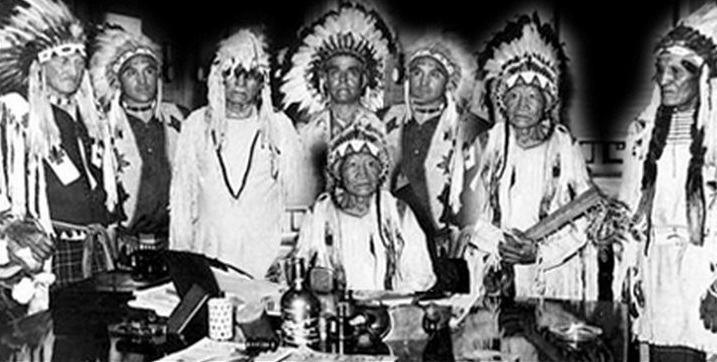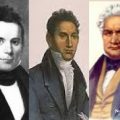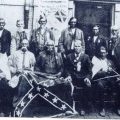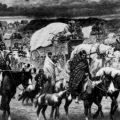
At the beginning of the nineteenth century, that great American visionary Thomas Jefferson proposed that Indian nations be moved to territories west of the Mississippi River so that they would not hinder American economic development. Government policies during the first half of the nineteenth century forced the removal of many Indian nations and thousand of Indian people to new “reservations” in the west. During the second half of the nineteenth century, Manifest Destiny and American greed caught up with the removed Indian nations. The governmental mantra became assimilation and the idea that reservation lands and resources should be developed by non-Indians.
In 1893, Congress established the Commission to the Five Civilized Tribes (commonly known as the Dawes Commission) to persuade the leadership of the Indian nations in Oklahoma to give up title to their land so that it could be allocated to individuals. The primary governmental concern at this time was for Indians to become assimilated into the dominant culture. In addition, dissolution of tribal governments would clear the way for what had been Indian Territory to become a part of Oklahoma and for Oklahoma to become a state. Powerful non-Indian groups pushed for this as an opportunity to make a profit. With regard to the Cherokee, an Indian nation which had been removed from their aboriginal homelands and had created an American-style democratic government in the west, this meant that the United States sought to dissolve the Cherokee government.
In 1894, the Cherokee told the Dawes Commission that something as momentous as allotment must be discussed by the people at length. Furthermore, they suggested that the United States first settle all outstanding claims from previous treaties. Historian Andrew Denson, in an article in Chronicles of Oklahoma, reports:
“This reluctance to embrace allotment left the American commissioners mystified and angry. Advocates of the policy at this time were convinced that common landholding and tribal government were doomed.”
There were at this time 41,824 Cherokees in the west and of these 8,703 (21%) were classified as full-bloods.
In 1895, Cherokee leader Bird Harris proposed that the Cherokee move to Mexico in order to preserve their culture and heritage. A large meeting was held at which Harris proposed a large reservation—100 miles by 300 miles—in Mexico. As an alternative to Mexico, he suggested Colombia. E.C. Boudinot traveled to Washington, D.C. to discuss the possibility of Cherokee emigration with the foreign ministers of Mexico and Venezuela.
In 1896, the Dawes Commission was empowered by Congress to determine tribal citizenship. Ken Carter, in an article in Chronicles of Oklahoma, writes:
“The loss of control over citizenship was a serious blow to the power of the tribal governments that made it almost impossible to defend themselves against the government’s determined efforts to abolish them.”
The government’s rationale for giving the Dawes Commission power to determine citizenship was based on allegations that the tribal rolls were loosely kept. With regard to the Cherokee roll, Kent Carter, in another article in Chronicles of Oklahoma, reports:
“Throughout its existence, the Dawes Commission held firmly to the philosophy that it did not matter if a person had Cherokee blood because if he or she did not meet all the requirements of the various laws passed by Congress and the numerous opinions issued by government attorneys, they were not eligible for enrollment. It is a philosophy that drove contemporary lawyers to distraction and drives present day researchers to tears.”
The Curtis Act in 1898 extended the provisions of the Dawes Act over Indian Territory. This act allowed the federal government to break up the Indian reservations into individual allotments. At this time there were almost no Indians in the Territory who favored allotment. Theda Perdue and Michael Green, in their book The Columbia Guide to American Indians of the Southeast, write:
“Frustrated at the unwillingness of the tribes to negotiate allotment agreements, Congress simply mandated allotment and the termination of tribal governments.”
The Act stipulates that tribal governments would continue to exist only to issue allotment deeds to tribal members and to terminate any other tribal business.
The Cherokee objected to the bill and sent a delegation to Washington to testify but they were not allowed access to the rooms where committees were debating the bill. Corporate representatives, on the other hand, had free access to the committees. Business historian H. Craig Miner, in his book The Corporation and the Indian: Tribal Sovereignty and Industrial Civilization in Indian Territory, 1865-1907, describes the vote:
“There was no quorum; a roll call would have revealed that there were only a dozen men in the Senate.”
While the Cherokee opposed the Curtis Act, in the 1899 case of Stephens versus Cherokee Nation, the Supreme Court upheld the constitutionality of the Curtis Act.
In 1900, a delegation of Cherokee traveled to Mexico with the intent of finding out if a reservation could be established for them in the Mexican states of Sonora or Sinaloa.
The Board of Indian Commissioners in 1901 declared that the purpose of the Indian Office (now known as the Bureau of Indian Affairs) was “to make all Indians self-supporting, self-respecting, and useful citizens of the United States.”
In 1901, all members of the Five Civilized Tribes in Oklahoma were granted citizenship by an act of Congress. This meant that every Indian adult male was a registered voter. This was an attempt to increase the number of voters in Oklahoma territory so that it could gain statehood.
In 1902, the Dawes Commission attempted to force enrollment on the Cherokee. Many of the full bloods, members of the Kootoowah Society, refused to submit to the process. In her book The Cherokees, Grace Steele Woodward reports:
“Hiding from the agents in inaccessible and out-of-the-way places known only to Keetoowahs, they eluded capture as long as possible. And many of these full bloods when captured purportedly preferred imprisonment to enrollment.”
In 1903, the Five Civilized Tribes Executive Committee passed a resolution asking each tribal council to petition Congress for statehood for Indian Territory.
In 1903, the Cherokee elected William C. Rogers as principal chief. The Indian Chieftain reported:
“So far as the chief’s election is concerned, the last political battle that the Cherokee will ever engage in has been fought out.”
The article concludes:
“As the nominal head of a defunct nation the chief will have little authority.”
In 1905, Cherokee chief William C. Rogers refused to call for tribal elections as the U.S. Congress had declared that the Cherokee government would not continue past 1906. Nevertheless, the elections were held and many opponents to Rogers were elected. Rogers notified the tribal council that he did not consider it to be legally elected. While Rogers was in Washington, D.C, the tribal council voted to impeach him and named Frank Boudinot as principal chief. However, the secretary of the Interior simply re-appointed Rogers to the position.
In 1905, the Cherokee Keetoowah Society, composed primarily of full-bloods, became incorporated. However, the Keetoowah were soon factionalized, and Redbird Smith and his followers who were opposed to allotment formed the Nighthawk Keetoowahs.
In 1905, representatives from the Cherokee, Creek, Seminole, and Choctaw nations held a convention at which they drew up a constitution for the state of Sequoyah, which would be separate and distinct from Oklahoma Territory which was seeking statehood. The call for the convention was issued by W.C. Rogers, the Cherokee Principal Chief, and by Green McCurtain, the Choctaw chief. The issue of whether Oklahoma should be one state or two was summed up by the Muskogee Phoenix:
“There are in Indian Territory some few persons who desire two states made of the two territories and who honestly believe this can be done. There are some persons who desire conditions to remain as they now are and who know that to fight for two states is to fight for no statehood legislation, and this makes them especially active.”
In her book And Still the Waters Run: The Betrayal of the Five Civilized Tribes, Historian Angie Debo reports:
“The constitutional convention was characterized even by a hostile newspaper as the most representative body of Indians ever assembled in the United States.”
The constitution for the state of Sequoyah was submitted to the voters: the turnout was light, but the vote was strongly in favor of it. The measure was presented to Congress which simply ignored it. According to Angie Debo:
“There was never the slightest chance that Congress would consent to the admission of two Western, radical, and probably Democratic, states in the place on the map that could be occupied by one.”
Congress, in 1906, passed an Act to Provide for the Final Disposition of the Affairs of the Five Civilized Tribes in Oklahoma. The Department of the Interior took over the Indian schools, school funds, and tribal government buildings and furniture. The law provided that the President may appoint a principal chief for any of the tribes. If a chief failed to sign a document presented to him by U.S. authorities, he was either to be replaced or the document could be simply approved by the Secretary of the Interior.
Congress passed the Oklahoma Enabling Act in 1906 as one step in the creation of the state of Oklahoma. The Act combined Oklahoma Territory and Indian Territory. With regard to Indians, the Act imposed a condition on the state constitution: Oklahoma cannot limit federal authority over Indians within its boundaries.
In 1906, the Cherokee Nighthawk Keetoowah Society changed Redbird Smith’s title from Chairman to Chief as a political statement which pointed out that the Cherokee now have no principal chief.
The state of Oklahoma was created in 1907. With statehood, tribal governments in the area were dissolved. Indians constituted only 5% of the population of the new state.



Leave a Reply